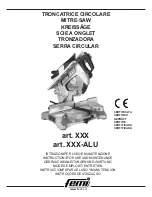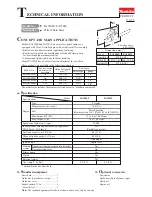
E N G L I S H
27
en - 6
The riving knife should be correctly set; the distance between
the toothed rim and the riving knife should be 1-3 mm (fig. G4).
Adjusting the anti-kickback fingers for (bevel) ripping (fig. G5)
• Loosen the knob (70) and lower the bracket (71) until the hold down
spring (72) just touches the surface of the workpiece.
• The tips of the anti-kickback fingers (60) should now be 3 mm below
the surface of the workpiece and the angle should now be as shown in
figure G5.
• For bevel ripping, loosen the Allen screw (73) and set the anti-kickback
fingers to the required angle.
Adjusting the riving knife, finger guard and anti-kickback fingers for
cross-cutting (fig. G2)
• For cross-cutting, adjust the riving knife and anti-kickback fingers up
and out of the way.
• Loosen the lever (74) to position the finger guard (61) just above the
workpiece and lock the lever (74).
Scale adjustments (fig. H1 - H5)
Rip scale
Ripping can be done with the motor in two positions. Each mode requires
its own direction of feed:
Position
Direction of feed
- In-rip
from right to left (fig. H1)
- Out-rip
from left to right (fig. H2)
The pointer (75) indicating the ripping width on the rip scale (76) is
adjustable (fig. H3):
• Place the fence in rearmost position.
• Place a board of 24 mm against the fence.
• Unlock the yoke clamp lever (53) press the yoke latch (54) (fig. H1) and
position the motor in out-rip position (fig. H2).
• Move the yoke assembly along the radial arm until the blade just
touches the edge of the material.
• Loosen the two screws (77) and move the pointer (75) until the edge of
the out-rip pointer (78) lines up with the known width of the board on
the lower scale (fig. H3).
• Tighten the two screws (77).
• Place the motor in in-rip position.
• Raise the guard to allow the blade to rest against the face of the fence.
• The in-rip pointer (79) should now line up with the zero position in the
upper scale. Adjust if necessary.
Bevel scale (fig. H4)
• Check that the bevel scale (20) reads 0° when positioned for a vertical cut.
• If required, loosen the screws (51) and adjust the pointer to 0°.
Mitre scale (fig. H5)
• Check that the mitre scale (82) reads 0° when positioned for a vertical cut.
• Adjust the pointer (81) to register 0° using the screw (83).
The mitre scale has preset positions at 45° left and right and at 0°.
Yoke travel stop (fig. A2, J1 & J2)
The yoke travel stop (14) must be adjusted to avoid that the bearings on
the yoke assembly hit the rear limit of the bearing tracks (fig. A2).
• Push the yoke assembly as far as it will go, pull it forwards approx.
5 mm and lock it the using the riplock (fig. A2) (15).
• Adjust the yoke travel stop (14) by slackening the nuts (85) in the front
slot (84) until the rubber stop (86) butts against the back of the riplock
housing.
• Tighten the nuts (85) (fig. J1).
When cross-cutting, tighten one nut in the front slotted hole
and one in the rear slotted hole (80) (fig. J2).
Mounting the return spring (fig. K)
• Mount the return spring (87) behind the yoke travel stop (14) using the
corresponding bolts and attach the end of the cable to the riplock (15)
using the screws (88).
Consult your dealer for further information on the appropriate accessories.
Instructions for use
• Always observe the safety instructions and applicable
regulations.
• Ensure the material to be sawn is firmly secured in place.
• Apply only a gentle pressure to the tool and do not exert side
pressure on the saw blade.
• Avoid overloading.
• Install the appropriate saw blade. Do not use excessively worn
blades. The maximum rotation speed of the tool must not
exceed that of the saw blade.
• Do not attempt to cut excessively small pieces.
• Allow the blade to cut freely. Do not force.
• Allow the motor to reach full speed before cutting.
• Make sure all locking knobs and clamp handles are tight.
• Never run the machine without the guards in place.
• Never lift the machine by the table top.
• Always refer to figure L to check the fence position and type.
The attention of UK users is drawn to the “woodworking machines
regulations 1974” and any subsequent amendments.
Switching ON and OFF (fig. A1)
The ON/OFF-switch of your radial arm saw offers multiple advantages:
- no-volt release function: should the power be shut OFF for some
reason, the switch has to be deliberately reactivated.
- motor overload protection device: in case of motor overload, the power
supply to the motor will be cut OFF. If this happens, let the motor cool
for 10 minutes and then press the reset button (22).
• I = ON
The tool now works in continuous operation.
• O = OFF
Making a trial cut (fig. A1)
• With the mitre latch lever (9) engaged, lock the mitre clamp lever (10)
so that the blade is positioned for a straight 0° cross-cut.
• Release the riplock (15) and push the yoke assembly back until the
blade is behind the fence.
• Lower the arm until the blade almost touches the table top.
• Place the workpiece against the front of the fence.
• Switch ON and lower the arm to allow the blade to cut a shallow
groove in the table surface.
• Pull the blade towards you so that it cuts a vertical slot in the wooden
fence and through the workpiece.
• Return the blade back to rest position and switch OFF.
• Check that the cut is a true 90° in all planes and adjust if required.
Basic Saw Cuts (fig. L1 - L5)
The teeth of a new blade are very sharp and can be dangerous.
Cross-cutting (fig. A1 & L1)
• Set the radial arm at right angles to the fence.
• Engage the mitre latch lever (9) in 0° position and tighten the mitre
clamp lever (10) (fig. A1).
• Lower the blade.
• Adjust the finger guard so that it just clears the workpiece.
• If there is no slot in the table top, cut one as described above.
















































